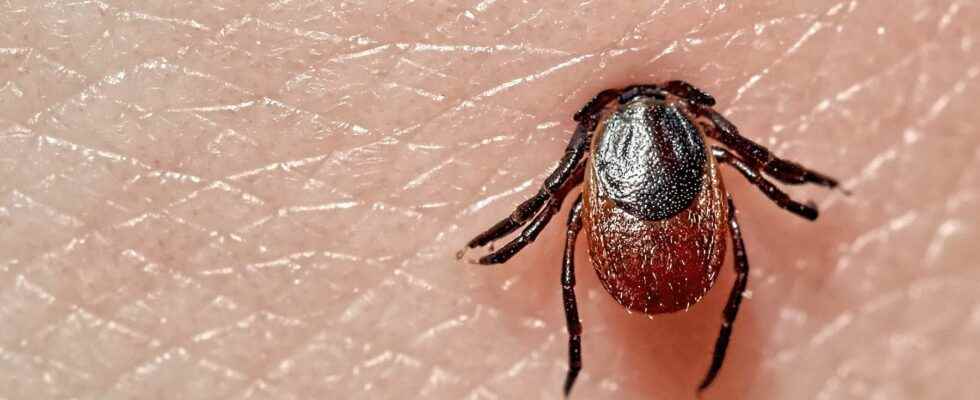Ticks are well known for transmitting Lyme disease. But some common species in France can infect us with pathogens. Here are the diseases you can catch after a tick bite.
You will also be interested
[EN VIDÉO] Lyme disease Lyme disease can be contracted following a tick bite carrying the bacteria Borrelia burgdorferi. Symptoms of fever, fatigue and headache can spread to infection in the heart, joints and nervous system if the disease is not treated.
There are about 900 species ticks in the world, of which about forty are present in France. But, like the mosquitoesticks are likely to spread disease some of which are difficult to treat. Ticks transmit agents pathogens through their saliva, injected during the sting. ” Saliva also contains inhibitors of immune system of the host, which generates a very favorable environment for the development of these pathogens “, explain Nathalie Boulanger and Sarah Bonnet in their book Lyme Ticks and Co.. Each species of tick is a vector for different diseases, and its ability to transmit a pathogen also depends on climatic conditions or the abundance of the vector. Are mentioned here the diseases affecting humans and present in France, knowing that ticks are also responsible for serious diseases in pets or breeding.
Lyme disease (or Lyme borreliosis)
- infectious agent : bacterium Borrelia
- vector tick : ticks of the genus Ixodes (the risk is greatest during its active period in the spring andfall)
- Incubation period : three to thirty days
- Symptoms : in 60% to 80% of patients, the infection begins with a erythema migrans (red spot about five centimeters in diameter that extends centrifugally). The disease can then progress to a disseminated phase, which generates a wide variety of symptoms: facial paralysis, pains intermittent pain, severe headaches, heart problems, neurological problems (dizziness, mental confusion, tingling sensation in the hands or feet), joint pain.
Rickettsioses
The rickettsioses that affect humans are fever spotty Mediterranean and the Tibola (Tick-born Lymphadenopathy).
- infectious agent : type bacteria Ricketta (R. conorii, R. slovaca Where R. raoultii)
- vector tick : Rhipicephalus sanguineus, Dermacentor reticulatus, Dermacentor marginatus
- Incubation period : one to ten days
- Symptoms : black spot at the site of the bite, then fever, fatigue, headache, skin rash. Mediterranean spotted fever can progress to serious forms in 5% to 6% of cases, while Tibola generally does not cause complications.
Anaplasmoses
- infectious agent : Anaplasma phagocytophilum
- vector tick : Ixodes ricinus
- Incubation period : one to two weeks
- Symptoms : syndrome flu-like (fever, chills, headache, muscle and joint pain), malaise, sometimes accompanied by digestive upset and skin rash. Very rare fatal cases (approximately 1%) have been reported.
Tularemia
- infectious agent : bacteria Francisella tularensis
- vector tick : a large number of species can spread the disease including Dermacentor andersoni
- Incubation period : three to five days
- Symptoms : fever attacks, hepatosplenomegaly (increased volume of liver and some missed), intestinal disorders, extreme fatigue. The disease can then evolve in very different forms: ulcers, swelling of the lymph nodestyphoid state which can give a atypical pneumonia. The mortality rate is around 6% when the disease is not treated.
Did you know ?
Why ticks are a good disease vector
- The large amounts of blood they absorb increase the likelihood of acquiring, storing and transporting infectious agents.
- Many of them are telotropic, that is, they feed on many different hosts, thus promoting the circulation of pathogens between species.
- They have exceptional longevity (up to several years for soft ticks), which helps keep pathogens in the wild.
- They reproduce very quickly: up to several thousand eggs at once for a female, which maintains a high tick population in the wild.
- They have a strong ability to disperse, via the movement of their host.
- Their saliva has anesthetic properties, so the bite goes unnoticed by most people.
Q fever
- infectious agent : bacteria Coxiella brunetii
- vector tick : about forty species of ticks can transmit the disease. Transmission occurs mainly through inhalation infected dust, especially among workers in close contact with farm animals (which are asymptomatic hosts)
- Incubation period : two to three weeks
- Symptoms : In 60% of patients, the disease remains asymptomatic. In the others, it mainly manifests itself in three clinical forms: flu-like syndrome (fever, chills, headaches, muscle and joint pain), atypical pneumonia and hepatitis acute. In 60% of patients, it remains asymptomatic.
Tick-borne encephalitis (TBE)
- infectious agent : Flavivirus
- vector tick : ticks of the genus Ixodes (the virus can be transmitted directly through the bite or through raw dairy products from infected animals)
- Incubation period : one to two weeks
- Symptoms : flu-like syndrome, then phase febrile with neurological signs of gravity variable in a third of patients. In 5 to 15% of patients, the infection can spread to the brain and trigger meningoencephalitis. Deaths are rare (less than 1%, mainly in the elderly).
babesiosis
- infectious agent : parasite gender blood Bebesia
- vector tick : ticks of the genus Ixodes, Dermacentor Where Rhipicephalus
- Incubation period : one to four weeks
- Symptoms : the disease is usually asymptomatic in healthy people. On the other hand, it can cause serious forms in immunocompromised patients: high fever, multi-organ damage, anemia, haemoglobinuria, jaundice and renal failure. The mortality rate can reach 40%.
Warning: even in the absence of transmission of infectious agents, ticks can cause health problems simply because of the bite. Some people may develop a allergy saliva, or superinfection of the wound.
Interested in what you just read?
Subscribe to the newsletter Health question of the week : our answer to a question you ask yourself (more or less secretly). All our newsletters
